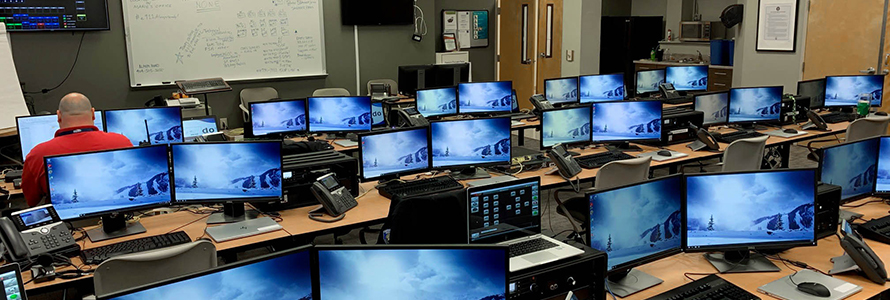This article originally appeared in the August/September 2019 edition of APCO’s PSC Magazine.
Talk to an experienced 9-1-1 call taker or dispatcher and they will tell you that they can usually discern how a call needs to be handled within the first few seconds. They are masters of identifying the information they need quickly and efficiently, even though no call is ever exactly like another.
In our increasingly data-driven world, that skill will be more and more valuable. Initiatives such as FirstNet and Next Generation 9-1-1 (NG9-1-1) are driving the technological innovations and forward planning that will poise our emergency communication centers (ECCs) to become part of a 360 view of an incident. NG9-1-1 will improve the connection between the community and ECCs, and FirstNet will help connect the responders in the field to public safety telecommunicators and vice versa.
I started at the First Responder Network Authority more than three years ago, and in that short amount of time, FirstNet — the nationwide public safety broadband network — has come a long way. This is the network that APCO and its members fought for, and we are proud to support 9-1-1 call takers and dispatchers as primary users on FirstNet. Though still in the initial stages of deployment, FirstNet is a communications platform ready to be put to work today, and ECCs are beginning to implement FirstNet services in various ways, including tactical dispatching.
FirstNet and Tactical Dispatching for the “Big Game”
When Super Bowl LIII came to Atlanta, the Fulton County Emergency Services’ E9-1-1 Center (E9-1-1 Center) had to be ready for anything. While the bulk of the radio channels were planned to be carried by the City of Atlanta during the “Big Game”, if anything went wrong Fulton County was the failsafe. The county’s E9-1-1 Center provides emergency radio dispatch services for more than 13 public safety agencies within the county, including police, fire and EMS. Their dispatch center is located in downtown Atlanta, only three blocks from the Mercedes-Benz Stadium, which hosted the game. Jim Millsap, technical division chief for the Fulton County E9-1-1 Center, knew that if an incident happened and an evacuation was necessary, a backup location for the E9-1-1 Center had to be ready to go.
Planning for the backup site began nearly a year before game day. Fulton County Airport was selected for the remote site as it is outside of Atlanta’s perimeter, but still easy to reach. The backup center was equipped with a voice over IP system, portable radio dispatch boxes and Fulton’s computer-aided dispatch (CAD) software, mirroring the main 9-1-1 emergency communications center. A few months before the “Big Game”, Millsap and his team used a major repair of a water main leak to exercise their backup plan. This gave the team a real chance to ensure all bases were covered. To add redundancy for the backup site, Fulton County E9-1-1 turned to FirstNet.
When events bring a massive influx of people into a city, a reliable communications network is an absolute necessity. With FirstNet, public safety can rely on priority and preemption for an “always-on” connection during large events. Fulton County Emergency Services was already a FirstNet subscriber, and Millsap was able to obtain 30 FirstNet Ready™ devices and deploy them as a safety net.
In the days leading up to the Super Bowl, Fulton staffed the backup center with eight dispatch positions, five call taker positions and two supervisors. Rather than wait for something to happen, Millsap preemptively moved the E9-1-1 Center and for two full days leading up to and during the game, Fulton County ran its regular dispatch out of the remote center. Only two staff members stayed at headquarters. Ten of the FirstNet Ready™ devices were handed out to command staff and the other 20 were charged and ready to back up the voice over IP system if needed. The plan was to forward calls to the FirstNet Ready™ devices, and a spreadsheet was maintained with the FirstNet cellphone numbers if this needed to be operationalized.
“We tested everything. It worked beautifully the week leading up to the Super Bowl and during the Super Bowl,” said Millsap. “In the end, it was a very successful mission. Everything worked as we wanted it to, and we had the backup of the FirstNet phones if needed.”
In addition to setting up the remote E9-1-1 Center, Millsap was responsible for deploying and supporting emergency communications for the Georgia World Congress Center, a 3.9 million square foot exhibition space next to the stadium. The radio team was on the ground for ten days, 24/7, and as the team set up communications they found areas inside the building that weren’t well covered. In these instances, Millsap had radio system technicians use a push-to-talk app on the FirstNet mobile devices to augment radio coverage where it was needed.
“You had to prepare for the unknown,” Millsap reflected. “We were seeing all the law enforcement incidents happening real time. They turned out to be nothing serious, but to be able to have that back up to our radio system with FirstNet was a huge advantage for us.”
The Vince Lombardi Trophy, fans and media bonanza may have left town, but FirstNet is still ready to support Fulton County. Millsap explained that Fulton County Emergency Services is in the process of loading a CAD app onto the 30 FirstNet Ready™ devices it used at the remote center during that Super Bowl. With a CAD application on handheld mobile devices, officers will be able to run a tag, show themselves out on a call, or access other information that improves their situational awareness. These devices will also be used as part of a mobile command center to support future large events in the county like concerts at Wolf Creek Amphitheater, which regularly bring thousands of music lovers into the area.
On the horizon with FirstNet
One thing is for certain, we are only scratching the surface of FirstNet’s potential for enhancing and augmenting public safety communications. Emerging mission critical services are going to impact our ECCs in near real time.
For example, the first iteration of Mission Critical Push to Talk (MCPTT) is on its way. Today, commercial push to talk is available to public safety, but there is no guarantee of connection times and delivery rates. While this has been improved with FirstNet’s priority and preemption capabilities, future push to talk applications will take this a step further and be built to international mission critical standards. MCPPT and land mobile radio (LMR) will augment and complement each other, and as public safety agencies and ECCs begin to operationalize MCPTT, processes or procedures will need to be considered — for example, the need for a consolidated view, management of talk groups, and data storage.
A little further down the road, standards for Mission Critical Video and Data are coming. As with push to talk, FirstNet’s priority and preemption have already improved the speed and reliability of mobile broadband for public safety, including for sending critical video and data. Mission Critical Video and Data standards will work to improve the delivery of video and data in real time. So, if an officer turns on his or her body-worn camera, the feed from the camera can be pulled up immediately to see what is happening live on the ground. For data, mission critical standards mean dispatchers know that their lifesaving information is getting through in real time — from critical call updates to viewing blue prints for access points or relaying that there is someone armed and dangerous on scene. This data is key to situational awareness, and ECCs will greatly benefit from the faster connection times and lower latency to come with Mission Critical Data standards.
Engage with the First Responder Network Authority
These are exciting times for emergency communications, and it’s clear that innovation is on its way. While there is much more work to be done to help ECCs truly take advantage of what FirstNet’s dedicated public safety broadband network has to offer, ECCs are not in this alone. The First Responder Network Authority is here to serve as a catalyst for innovation and to ensure FirstNet advances to meet the critical communications needs of the 9-1-1 community. We have established a process for a Roadmap that will guide us over the next five years and beyond.
FirstNet is YOUR network — and we want to hear from you. Please reach out to a public safety advisor in your area via FirstNet.gov for engagement opportunities. FirstNet is proud to support public safety telecommunicators — the lifeline for their communities.




















